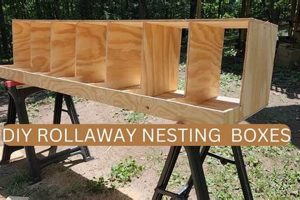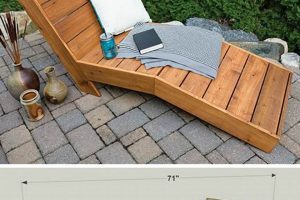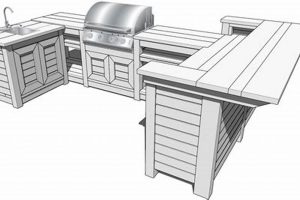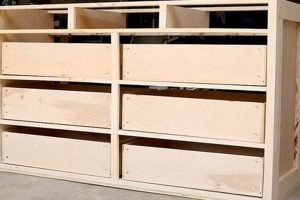The concept involves self-directed construction of a home or commercial bar structure using personally sourced materials and designs. Individuals undertake the project from conception to completion, often tailoring the final product to their specific spatial needs and aesthetic preferences. An example includes constructing a wet bar in a basement using reclaimed wood and a custom-built countertop.
This approach provides cost savings compared to purchasing pre-fabricated units or hiring professional contractors. It allows for personalized customization to match existing decor or specific functional requirements, offering greater control over the final appearance and features. Furthermore, it can foster a sense of accomplishment and provide an opportunity to develop woodworking or construction skills. Historically, self-sufficiency in home improvement projects has been a valued practice, emphasizing resourcefulness and individual craftsmanship.
The subsequent sections will detail considerations for designing a bar, selecting suitable materials, understanding essential construction techniques, and addressing potential challenges encountered during the build process.
Essential Guidance for Bar Construction
The following offers crucial guidance for individuals embarking on self-directed bar construction. Careful consideration of these points will contribute to a successful and aesthetically pleasing outcome.
Tip 1: Conduct Thorough Spatial Assessment: Prior to initiating any construction, precise measurements of the intended location are essential. Account for plumbing, electrical access, and clearance for seating and movement. For instance, consider the space needed for bar stools and behind-bar circulation.
Tip 2: Develop Detailed Schematics: Accurate and scaled drawings serve as the blueprint for the project. Include dimensions of all components, placement of shelves, sinks, and refrigeration. Example: Illustrate the height and depth of the bar top, considering standard ergonomic measurements.
Tip 3: Select Appropriate Materials: Material choice impacts both aesthetics and durability. Hardwoods like oak or maple are suitable for bar tops, while stainless steel is ideal for sinks. Moisture resistance is a critical factor in material selection.
Tip 4: Prioritize Structural Integrity: The frame supporting the bar must be robust and capable of bearing significant weight. Employ joinery techniques such as mortise and tenon or pocket screws for secure connections. Reinforce corners with metal brackets for added stability.
Tip 5: Adhere to Local Building Codes: Ensure all construction complies with local regulations regarding plumbing, electrical work, and fire safety. Consult with local building inspectors to confirm adherence to code.
Tip 6: Plan for Efficient Plumbing and Electrical Systems: When incorporating a sink, proper drainage and water supply lines are paramount. Similarly, electrical outlets must be strategically placed and safely wired by a qualified electrician.
Tip 7: Implement Effective Lighting: Lighting enhances ambiance and functionality. Install task lighting above the bar for preparing drinks and ambient lighting to create the desired atmosphere. Dimmer switches provide control over light intensity.
A meticulous approach to planning and construction, coupled with adherence to safety guidelines, will yield a professional-quality bar. Attention to detail throughout the build process is vital for ensuring structural soundness and aesthetic appeal.
The subsequent section will discuss common pitfalls and troubleshooting strategies for self-directed bar construction.
1. Spatial Assessment
Spatial assessment forms the cornerstone of any successful self-directed bar construction project. It provides the essential framework upon which design and material choices are predicated, ensuring that the finished structure is both functional and aesthetically integrated within its environment.
- Dimensional Analysis
This involves the precise measurement of the intended location for the bar, considering length, width, and height. Obstructions such as pipes, support beams, or electrical outlets must be accurately documented. An example would be calculating the available wall space for a built-in bar in a living room, accounting for window and door placements. Failure to conduct proper dimensional analysis may lead to design flaws and construction complications.
- Traffic Flow Evaluation
The assessment should consider how people will move around the bar area, both in front of and behind the bar. Sufficient space for seating, standing, and passage must be allocated. A narrow passageway behind the bar could impede functionality and safety. Considerations include the placement of bar stools to ensure adequate legroom and ease of access.
- Utility Integration Planning
Spatial assessment necessitates identifying the locations of existing plumbing and electrical connections. The bar’s design must accommodate these utilities, and plans must be made for extending or modifying them as needed. Installing a wet bar requires careful planning for water supply and drainage lines, which may necessitate professional plumbing services. Improper integration of utilities can lead to costly repairs and safety hazards.
- Aesthetic Harmony Considerations
The planned bar should visually complement the existing decor and architectural style of the room. The color scheme, materials, and overall design should be in harmony with the surrounding environment. A modern stainless steel bar may clash with a rustic-themed living room, indicating the need for alternative design choices.
These facets of spatial assessment collectively dictate the feasibility and scope of the “bar plans diy” project. Accurate measurements, thoughtful traffic flow planning, strategic utility integration, and aesthetic harmony are crucial for a functional and visually pleasing result. Disregarding spatial considerations often leads to compromised functionality, aesthetic disharmony, and costly redesigns.
2. Design Schematics
Design schematics are foundational to the successful execution of self-directed bar construction. They provide a visual representation of the bar’s structure, dimensions, and functionalities, serving as a blueprint for the entire project. The absence of well-defined schematics often results in structural inaccuracies, inefficient space utilization, and increased material waste. A practical example involves creating detailed elevations of the bar’s front, back, and sides, incorporating precise measurements for shelving, cabinetry, and countertop overhangs. These detailed drawings mitigate the risk of miscalculations during the building phase, contributing to a more professional and accurate final product.
Furthermore, design schematics facilitate the integration of essential systems like plumbing and electrical wiring. Diagrams specifying the precise location of water lines, drainpipes, and electrical outlets are crucial for avoiding costly errors and ensuring code compliance. Consider a scenario where a wet bar design fails to account for adequate space behind the bar for plumbing connections, potentially leading to disruptive and expensive modifications after construction has commenced. Detailing the placement of lighting fixtures and power outlets on the schematics ensures optimal functionality and aesthetic appeal, contributing to the bar’s overall usability and design coherence.
In summary, design schematics are indispensable for navigating the complexities of self-directed bar construction. They provide a roadmap for the entire process, minimizing errors, optimizing resource allocation, and ensuring the successful integration of functional and aesthetic elements. While the creation of detailed schematics may require specialized knowledge or software, the investment in proper planning significantly reduces the risk of complications and enhances the final product’s quality and longevity. The level of detail in the schematics directly correlates with the success of the project and the satisfaction derived from the finished bar.
3. Material Selection
Material selection is integral to the execution of “bar plans diy” projects, directly influencing structural integrity, aesthetics, and long-term durability. The selection process dictates not only the appearance of the finished bar but also its resistance to moisture, wear, and potential damage from spills or impacts. For example, choosing solid hardwood for a bar top offers superior resistance to scratches and stains compared to cheaper alternatives like particleboard, but requires a higher initial investment and more specialized woodworking techniques. The effect of material choice reverberates throughout the entire project, influencing construction complexity and maintenance requirements.
The practical significance of understanding material properties is evident in several aspects of bar construction. For wet bars, materials must be resistant to water damage. Stainless steel sinks and components, along with sealed granite or quartz countertops, mitigate the risk of water penetration and subsequent structural degradation. Additionally, the choice of framing materials affects overall stability. Using kiln-dried lumber minimizes warping and ensures a level, sturdy base for the entire structure. Real-world examples demonstrate the consequences of neglecting material considerations; a bar constructed with untreated wood in a humid basement is prone to rot and mold, necessitating costly repairs or complete replacement.
Therefore, material selection is not merely a cosmetic consideration but a fundamental component that determines the success and longevity of a “bar plans diy” endeavor. A thoughtful and informed approach, taking into account structural requirements, environmental conditions, and aesthetic preferences, is crucial. Overlooking the impact of material properties can lead to compromised structural integrity, increased maintenance costs, and a diminished lifespan for the finished bar. The interplay between design, budget, and material characteristics requires careful evaluation to achieve a balance between functionality, aesthetics, and long-term value.
4. Structural Integrity
Structural integrity is a paramount consideration within the framework of self-directed bar construction. It pertains to the ability of the bar structure to withstand applied loads and stresses over its intended lifespan without experiencing failure or unacceptable deformation. The long-term functionality and safety of any bar built from self-generated plans are contingent upon the robust design and execution of its structural elements.
- Load-Bearing Capacity of Framing
The framing, typically constructed of wood or metal, must be capable of supporting the weight of the countertop, appliances (e.g., refrigerators, ice makers), and any items stored within or placed upon the bar. An improperly designed or constructed frame risks collapse or significant deflection under load. An example is a frame constructed of undersized lumber that bows under the weight of a heavy granite countertop. This necessitates reinforcement or complete reconstruction, resulting in increased costs and project delays. Proper load calculations are critical for selecting appropriate framing materials and dimensions.
- Joint Strength and Stability
The connections between framing members are crucial for distributing loads and maintaining structural stability. Weak joints, such as those created with inadequate fasteners or poorly executed joinery, can compromise the entire structure. A common issue arises when using insufficient screws or nails in the construction of a wooden frame, leading to wobbling or complete separation of components over time. Employing appropriate fasteners, such as lag bolts or structural screws, and utilizing robust joinery techniques, such as mortise and tenon or pocket-hole joinery, are essential for ensuring long-term stability.
- Countertop Support and Overhang
The design must account for the weight distribution of the countertop and any overhangs. Inadequate support beneath the countertop can lead to cracking, sagging, or even complete failure. An unsupported overhang of granite, for instance, is prone to fracture under minimal pressure. Proper support can be achieved through the use of corbels, brackets, or a reinforced substrate beneath the countertop. The placement and spacing of these supports must be calculated based on the countertop material, thickness, and overhang dimensions.
- Resistance to Lateral Forces
The structure must be capable of withstanding lateral forces, such as those exerted by leaning or accidental impacts. A bar that is not adequately braced may be prone to tipping or racking. In coastal regions or areas prone to seismic activity, additional bracing and anchoring may be required to resist wind or earthquake forces. Diagonal bracing within the framing and secure attachment to the surrounding walls or floor contribute to lateral stability.
These facets of structural integrity are not isolated considerations but rather interconnected elements that collectively determine the long-term performance and safety of a bar constructed using self-generated plans. Neglecting any aspect of structural design can have significant consequences, ranging from cosmetic damage to catastrophic failure. Adherence to sound engineering principles and building codes is essential for ensuring a structurally sound and durable bar that meets the intended functional and aesthetic requirements.
5. Code Compliance
Code compliance represents a non-negotiable aspect of self-directed bar construction. Adherence to local building codes and regulations is essential to ensure the safety of the structure and its occupants, avoid legal penalties, and facilitate potential future property transactions. Non-compliance can result in costly rework, fines, and, in extreme cases, the forced removal of the non-compliant structure.
- Electrical Safety Standards
Electrical codes mandate the use of grounded circuits, proper wiring techniques, and appropriately rated electrical components to minimize the risk of electrical shock and fire. Incorporating electrical outlets near a wet bar, for instance, necessitates Ground Fault Circuit Interrupter (GFCI) protection to prevent electrical hazards in wet environments. Deviation from electrical codes can result in dangerous conditions, invalidating insurance coverage and potentially causing property damage or personal injury.
- Plumbing Regulations
Plumbing codes dictate the requirements for water supply lines, drainage systems, and venting to ensure proper sanitation and prevent water contamination. Installation of a wet bar necessitates adherence to plumbing codes regarding pipe sizing, backflow prevention, and connection to the existing water and sewer systems. Failure to comply with these regulations can lead to leaks, water damage, and the potential for sewage backups, posing health risks and requiring expensive repairs.
- Structural Building Codes
Structural codes define the minimum requirements for the structural integrity of the bar, including load-bearing capacity, material specifications, and construction techniques. These codes aim to ensure the bar can withstand anticipated loads and environmental conditions without collapsing or posing a safety hazard. Building a bar with an unsupported countertop overhang, for example, could violate structural codes, leading to cracking, collapse, and potential injury. Proper framing and support systems, designed in accordance with structural codes, are essential for ensuring the safety and stability of the bar.
- Fire Safety Regulations
Fire safety codes address the use of fire-resistant materials, proper ventilation, and the installation of smoke detectors to minimize the risk of fire and ensure occupant safety in the event of a fire. The choice of materials for the bar’s construction, such as flame-retardant wood treatments or non-combustible countertop surfaces, must comply with fire safety codes. Furthermore, ensuring adequate ventilation and proper clearances around appliances are essential for preventing overheating and potential fire hazards.
Collectively, adherence to electrical, plumbing, structural, and fire safety codes is essential for any successful “bar plans diy” project. While self-directed construction offers opportunities for customization and cost savings, neglecting code compliance can have severe consequences. Consulting with local building inspectors or qualified professionals is advisable to ensure that the planned bar meets all applicable code requirements, safeguarding the health, safety, and financial well-being of the property owner and its occupants.
6. System Integration
System integration, within the context of self-directed bar construction, encompasses the coordinated assembly and functional meshing of all constituent components, including plumbing, electrical, structural, and aesthetic elements. The effectiveness of this integration directly dictates the usability, safety, and longevity of the bar. A failure to adequately integrate these systems can manifest as functional deficiencies, safety hazards, and premature structural degradation. For example, an improperly planned electrical system might lack sufficient outlets to power essential bar equipment, such as blenders or refrigerators, thereby diminishing the bar’s utility. Similarly, a poorly designed plumbing system could result in inadequate drainage, leading to unsanitary conditions and potential water damage.
A well-integrated bar design considers the sequential interdependence of each system. The structural framework must accommodate the routing of plumbing and electrical lines without compromising its load-bearing capacity. This often requires careful planning during the design phase, including the creation of detailed schematics that illustrate the precise location of all utilities and their connections to the existing infrastructure. Furthermore, aesthetic considerations, such as lighting and countertop materials, must be seamlessly integrated with the functional requirements of the bar. The placement of lighting fixtures, for example, should provide adequate illumination for both preparing drinks and creating a desired ambiance, while the selection of countertop materials must balance durability, aesthetics, and compatibility with the bar’s overall design.
In conclusion, successful self-directed bar construction necessitates a holistic approach to system integration. The coordinated assembly of all constituent components is not merely an additive process, but rather a synergistic endeavor that requires careful planning, meticulous execution, and a thorough understanding of the interdependencies between each system. Addressing the challenges inherent in system integration ensures a functional, safe, and aesthetically pleasing bar that meets the intended user needs and conforms to all applicable building codes.
Frequently Asked Questions About DIY Bar Plans
The following addresses common inquiries regarding self-directed bar construction, offering insights into crucial planning, design, and execution aspects.
Question 1: What are the primary benefits of utilizing self-directed bar plans?
Self-directed bar plans enable customization tailored to specific spatial constraints, aesthetic preferences, and functional requirements. They offer potential cost savings compared to prefabricated units or professional installations, allowing for greater control over material selection and design implementation.
Question 2: How critical is spatial assessment prior to initiating construction?
Spatial assessment is paramount. Accurate measurements and consideration of existing utilities (plumbing, electrical) are essential for preventing design flaws and construction complications. Proper spatial planning ensures optimal utilization of available space and facilitates seamless integration with the surrounding environment.
Question 3: What are the key considerations when selecting materials for bar construction?
Material selection hinges on durability, aesthetics, and resistance to moisture or potential damage. Hardwoods are suitable for bar tops, while stainless steel is appropriate for sinks. Compliance with relevant building codes is a fundamental requirement for material selection. These considerations guarantee longevity and safety.
Question 4: How crucial is structural integrity in self-directed bar construction?
Structural integrity is paramount. The bar’s frame must withstand significant weight and applied stresses. Robust joinery techniques and adherence to load-bearing specifications are essential for preventing collapse or deformation, ensuring the bar’s safe and reliable operation.
Question 5: What building codes typically apply to self-directed bar construction?
Applicable building codes often encompass electrical safety standards, plumbing regulations, and structural integrity requirements. Adherence to these codes is mandatory to ensure safety and legal compliance. Consultation with local building inspectors is advisable for confirming code adherence.
Question 6: What are the most common challenges encountered during self-directed bar construction?
Common challenges include inaccurate measurements, improper material selection, inadequate structural support, and non-compliance with building codes. Thorough planning, meticulous execution, and adherence to established construction principles mitigate these risks. Overcoming these challenges results in high-quality bar.
In summary, successful DIY bar projects need meticulous attention to detail across design, material selection, structural considerations, and code compliance. These elements work together to create a high-quality and safe bar.
The subsequent segment will explore troubleshooting strategies for addressing construction-related issues.
Concluding Observations on Bar Plans DIY
The preceding analysis has detailed the core components of self-directed bar construction, emphasizing the importance of spatial assessment, design schematics, material selection, structural integrity, code compliance, and system integration. A thorough understanding of these elements is critical for successfully executing “bar plans diy” projects. Neglecting any aspect can result in functional deficiencies, safety hazards, or costly rework.
Therefore, individuals contemplating “bar plans diy” should prioritize meticulous planning and rigorous adherence to established building principles. The long-term success and safety of a self-constructed bar depend on a commitment to quality craftsmanship and a comprehensive understanding of applicable codes and regulations. Thoughtful consideration of these factors will yield a durable, functional, and aesthetically pleasing addition to any space.







